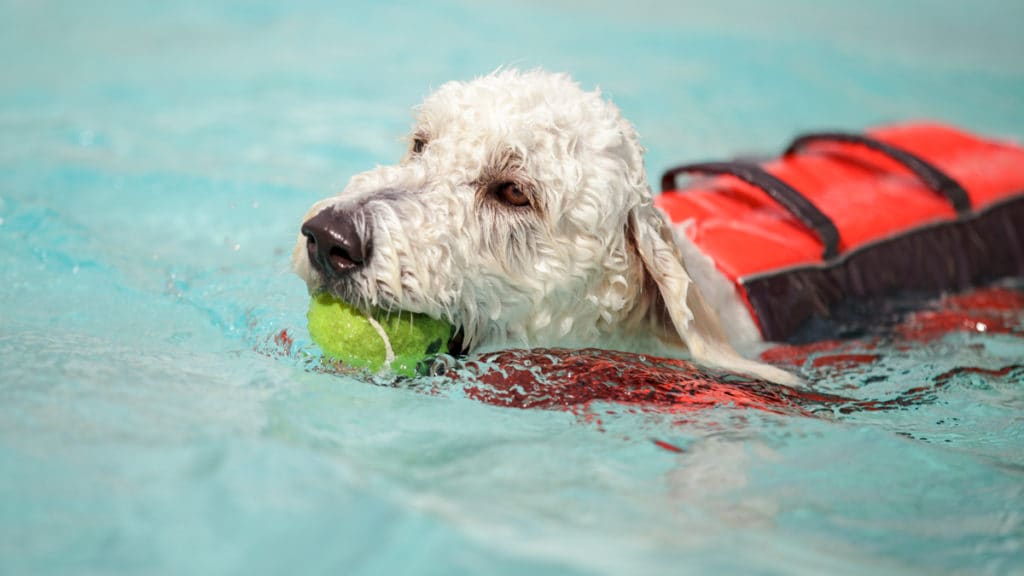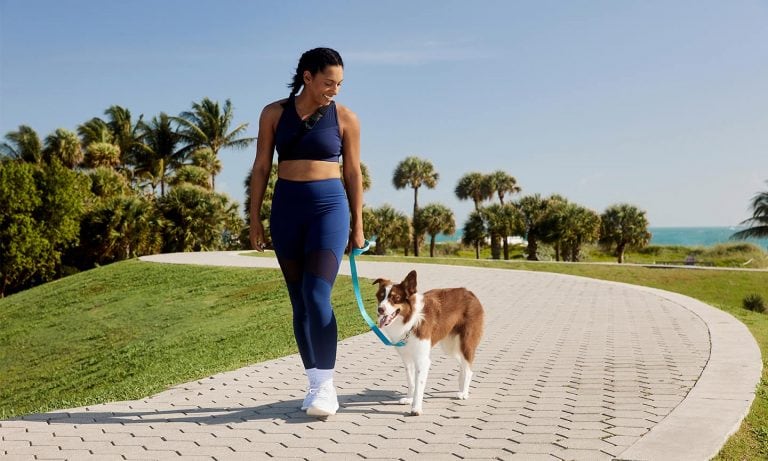Does your dog’s water bug personality make you question if she is hiding fins and scales under her fur? While some dogs are natural swimmers and never feel like a fish out of water while in it, not all pups take to swimming so easily. From non-swimmers and doggy paddle beginners to expert pup lifeguards, these nine swimming tips from Nicole Ellis, APDT, American Kennel Club (AKC) CGC evaluator, will make your pup a dog swimming specialist in no time!
1. See if your dog knows how to swim. Heavier, denser breeds, such as Pugs and Bulldogs, often don’t take to swimming as easily as Retrievers, for example. Dogs with shorter legs, such as Dachshunds, may also have a harder time swimming. Even if your dog used to swim when she was a younger pup, she can forget how to doggy paddle over time and should be slowly reintroduced to water before diving in. On the other hand, “if your dog has never been in the water before,” says Ellis, “introduce her to it properly by coaxing her with toys or wading in with her.” Never force your dog into the water—this will only create a sense of panic and make your dog afraid of dipping her paws back in. The key to teaching your dog how to swim is getting her comfortable in water without panicking. Starting in the shallow end and being patient is key to getting your dog swimming like an expert this summer.
2. Get her a life jacket. Certain dog breeds just don’t stay afloat as easily as others. Make sure your chunky or short-legged pup is comfortable in and around water this summer with dog life vests that will keep her from missing out on the summer fun! The Outward Hound Lifejacket for Dogs and Outward Hound PupSaver Ripstop Dog Life Jacket are dog life vests that will keep your beginner doggy paddle pup safe in the water. With a front float to keep your pup’s head above water, and dual handles for easy access in case of an emergency, the multi-buckle design will create a perfect fit.
For dog swimming experts, the Outward Hound PupSaver Neoprene Life Vest for Dogs and KONG AquaPro Dog Flotation Vest are great options to support your Olympic swimmer from getting too tired in the water. Both designs offer a snug fit to keep her comfortable for hours at the pool, beach or lake or on a boating trip, and feature a single handle that you can grab hold of in case of emergency in the water and out!
3. Start with your dog leashed. “To begin your swimming lesson [start] near shallow, current-free water that allows you to walk next to your dog,” Ellis recommends. “Keep the dog leashed at first, until you know she’s comfortable returning to you when you call.” Begin in still water, calling out to your pup as you get deeper and she can no longer reach the bottom to encourage her to start her doggy paddle. Keep her leashed until you know that she will come to you when called to keep her from running off. Never pull on the leash to force your dog to come to you when she is swimming; this will only frustrate and panic her, causing her to wear herself out or go underwater. Use verbal cues to encourage her to come when called.
4. Train your dog to “come” on command. “Being able to come to you when you call can be a lifesaver,” reminds Ellis. “Whether your pup is swimming too far from you or you feel like she needs a break, ‘come’ will be a useful tool.” Both in water and out, “come” can prove to be one of the most useful commands that your dog knows. Start with teaching your pup how to “stay,” start telling her to “come,” and reward her when she does.
5. Encourage your pup to use all four legs in her doggy paddle. Using all four legs for dog swimming will keep your dog from wearing herself out too quickly. Some pups try to just use their front two legs while doggy paddling, which can tire them out. “If your pet is relying too much on her front paws, give her some extra support by lifting her in the water until she begins moving all of her legs at the same time,” recommends Ellis.
6. Listen to your pup. If your dog still isn’t swimming like a pro, don’t give up! Start slow—if she seems nervous, place your arm under her belly to support her as she starts paddling to calm, support and assist her. And remember to take lots of breaks!
Teaching a pup to swim is much like teaching a child how to ride a bicycle. Steady support and patience will keep her confident and relaxed in the water. If your dog seems tired or anxious, Ellis recommends leaving her in the water to allow her to calm down before trying again. Remember to finish every training session on a positive note! Don’t give up if your dog panics and runs out of the water. Give her a chance to calmly wade in the shallow end at her own pace, and reward her when she does before going home.
7. Keep a fresh supply of water for her to drink. Provide plenty of drinking water for your pup to keep her hydrated while she is swimming. Especially important if you are swimming in an ocean, sea or pool, and in hot weather, fresh water will allow her to regain her energy and relax. The PetMate Silicone Round Collapsible Travel Pet Bowl is a durable bowl that will give your dog easy access to water and folds back down for travel and storage when you’re done!
8. Keep it fun! Bring some of your dog’s favorite toys and treats to keep her encouraged. Though treats shouldn’t be fed while swimming to avoid choking, keeping them shoreside will keep the experience fun and positive. Plastic and rubber dog toys that float will allow your best friend to play fetch in the water and keep her entertained and engaged for hours. The ChuckIt! Water Skimmer Flyer skips across the water and floats for high visibility for your dog to retrieve. Be sure to reward your pup with verbal praise and lots of pets.
9. Do a thorough spot check after every swim. “Thoroughly rinse [your dog’s] coat with clean water to remove any chemicals, sand or silt,” reminds Ellis. “Remember to check your dog’s paw pads for any
scrapes and wipe her ears dry to avoid an infection.” Earthbath Ear Wipes for Dogs & Cats are a portable and easy way to clean out your dog’s ears on the go.
Swimming is a great exercise for dogs and owners alike. Get your pup in on the fun this summer with these training tips and dog life vests that keep your dog comfortable and allow you to rest assured!
Share:
















